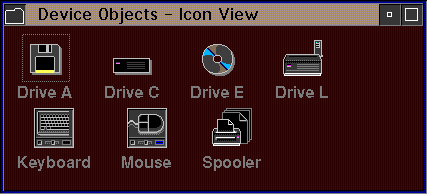A Container object holds other objects. Its primary purpose is to
provide a way for the user to group related objects for easy access and
retrieval. The following figure shows a Container object:
Data objects convey information, such as text or graphics, audio
or video information. The following figure shows a Data object:
A Device object often represents a physical object in the real world.
For example, a mouse object can represent the user's pointing device, and
a modem object can represent the user's modem. Some device objects represent
a logical object in the user's computer system rather than a physical object.
For example, a shredder object can represent a logical object that disposes
of the user's other objects. Some device objects can contain other objects.
For example, a printer object can contain a queue of objects to be printed.
The following figure shows a Device object: